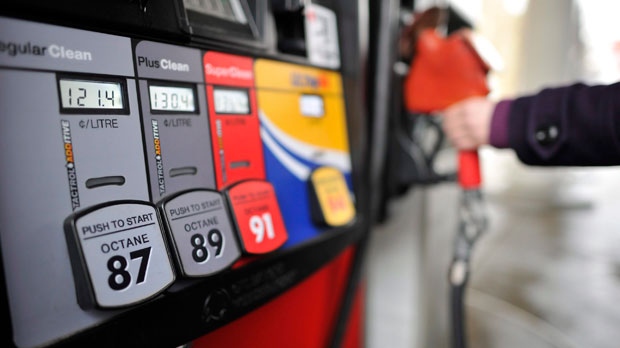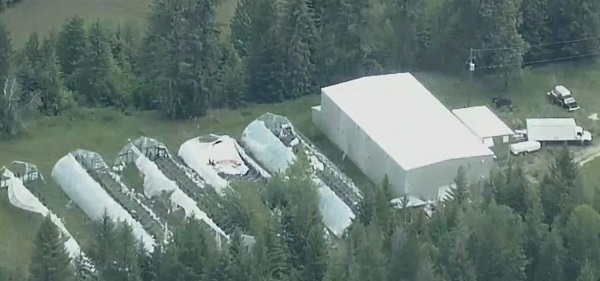Economy
Oil Lobby Working With Republicans Behind-The-Scenes To Push ‘Gateway’ To Carbon Tax

 From the Daily Caller News Foundation
From the Daily Caller News Foundation
By NICK POPE
America’s leading oil and gas trade group is working behind the scenes with moderate House Republicans to push support for a bill that critics say could lead to a domestic carbon tax, according to an email obtained by the Daily Caller News Foundation and sources familiar with the matter.
On May 14, Chris Boness, the director of federal relations for the American Petroleum Institute (API), sent an email to an API mailing list that named several House lawmakers intending to co-sponsor the PROVE IT Act alongside Republican Utah Rep. John Curtis. The trade group has also met with staffers to try to secure support for the bill, which API supports, according to sources familiar with the matter.
Assuming the House version is the same as the already-introduced Senate version, the bill would instruct the Department of Energy (DOE) to study the carbon intensity of goods — including aluminum, steel, plastic and crude oil — produced in the U.S. and the carbon intensity of products from other countries, according to E&E News.
Dozens of the PROVE IT Act’s critics have described the bill as a possible “gateway” to domestic carbon taxes because it would effectively instruct the federal government to calculate an implicit cost of carbon with few restrictions on how that official metric is used in the future.
“Thanks for those that joined today’s meeting,” Boness wrote in the email obtained by the DCNF. “Here is the list of current [Republican] cosponsors of the PROVE IT Act: Curtis, [Michigan Rep. Tim] Walburg (sic), [Ohio Rep. Bob] Latta, [New York Rep. Andrew] Garbarino, [Florida Rep. Maria Elvira] Salazar, [Michigan Rep. Mariannette] Miller-Meeks, [Indiana Rep. Larry] Bucshon, [Oregon Rep. Lori] Chavez-DeRemer. Additionally, [Georgia Rep. Buddy] Carter, [New York Rep. Mike] Lawler and [Pennsylvania Rep. Dan] Meuser seemed interested. Will keep you updated if others join and send updates on introduction.”
API representatives have had meetings addressing the PROVE IT Act with lawmakers’ offices, sources familiar with the matter told the DCNF. The offices of Curtis, Walberg, Latta, Garbarino, Salazar, Miller-Meeks, Bucshon and Chavez-DeRemer did not respond to questions about why they apparently support the bill.
Carbon pricing is broadly unpopular with Republicans, according to E&E News. Generally, polling indicates that Republicans do not consider climate change to be a problem in need of major government-led solutions and that energy affordability, for example, is a much stronger concern.
API Email re: PROVE IT Act by Nick Pope on Scribd

The bill’s proponents tout it as a measure to reward American companies for producing products more cleanly than foreign competitors, but opponents are strongly concerned that the bill instructs the federal government to effectively set a price on carbon with insufficient restrictions what the government can do in the future.
Notably, Republican West Virginia Sen. Shelley Moore Capito introduced an amendment to the Senate version that would prevent the data collected from being used as the basis for carbon taxes or tariffs, but Democrats killed that proposal while the bill sat in the Senate Environment and Public Works Committee.
Despite concerns from those opposed to the bill that it could be a first step to carbon taxes or tariffs, API supports the PROVE IT Act. Notably, API is in favor of carbon pricing.
“America’s oil and natural gas is produced under some of the highest environmental standards in the world,” a spokesperson for API told the DCNF. “Efforts like the PROVE IT Act are bipartisan opportunities to help study and quantify that advantage and demonstrate our industry’s commitment to producing cleaner, safer, and more affordable energy here at home while still supplying the energy our world needs.”
Some of the lawmakers API suggested could be interested in co-sponsoring the PROVE IT Act are wary, however.
Rep. Meuser, whose district includes energy-rich parts of Pennsylvania, is opposed to the bill as it stands, despite API’s suggestion that he is potentially interested in supporting it, a source familiar with Meuser’s thinking told the DCNF.
Rep. Carter is skeptical of policies that could lead to a carbon tax.
“Mr. Carter is reviewing the legislation,” a spokesperson for Carter told the DCNF. “He is absolutely opposed to anything that could lead to a carbon tax.”
In the eyes of those opposed to the bill, the PROVE IT Act would make it easier for a second-term Biden administration to pursue carbon taxes or tariffs that would hurt American consumers and certain types of energy producers.
“Our opposition to the PROVE IT Act is clear and concise. The latest attempt by some in Congress who are trying to create a structure that would lead to a domestic carbon tax will have price implications on our energy, particularly our fuel,” Tom Pyle, president of the American Energy Alliance, told the DCNF. “I do think that it is important to recognize that John Podesta made it clear that this is a second term agenda item for the Biden administration. And why would any Republican want to be the lead on helping President Biden further his war on affordable energy?”
Mike McKenna, a GOP strategist with extensive experience in the energy sector, expressed a similar view.
“The big problem with the bill is that it creates infrastructure to impose a carbon dioxide tax,” McKenna told the DCNF. “As everyone who has had more than ten seconds of exposure to the federal government knows, once that infrastructure can be put in place, it’s going to be used.”
Alberta
Alberta’s grand bargain with Canada includes a new pipeline to Prince Rupert

From Resource Now
Alberta renews call for West Coast oil pipeline amid shifting federal, geopolitical dynamics.
Just six months ago, talk of resurrecting some version of the Northern Gateway pipeline would have been unthinkable. But with the election of Donald Trump in the U.S. and Mark Carney in Canada, it’s now thinkable.
In fact, Alberta Premier Danielle Smith seems to be making Northern Gateway 2.0 a top priority and a condition for Alberta staying within the Canadian confederation and supporting Mark Carney’s vision of making Canada an Energy superpower. Thanks to Donald Trump threatening Canadian sovereignty and its economy, there has been a noticeable zeitgeist shift in Canada. There is growing support for the idea of leveraging Canada’s natural resources and diversifying export markets to make it less vulnerable to an unpredictable southern neighbour.
“I think the world has changed dramatically since Donald Trump got elected in November,” Smith said at a keynote address Wednesday at the Global Energy Show Canada in Calgary. “I think that’s changed the national conversation.” Smith said she has been encouraged by the tack Carney has taken since being elected Prime Minister, and hopes to see real action from Ottawa in the coming months to address what Smith said is serious encumbrances to Alberta’s oil sector, including Bill C-69, an oil and gas emissions cap and a West Coast tanker oil ban. “I’m going to give him some time to work with us and I’m going to be optimistic,” Smith said. Removing the West Coast moratorium on oil tankers would be the first step needed to building a new oil pipeline line from Alberta to Prince Rupert. “We cannot build a pipeline to the west coast if there is a tanker ban,” Smith said. The next step would be getting First Nations on board. “Indigenous peoples have been shut out of the energy economy for generations, and we are now putting them at the heart of it,” Smith said.
Alberta currently produces about 4.3 million barrels of oil per day. Had the Northern Gateway, Keystone XL and Energy East pipelines been built, Alberta could now be producing and exporting an additional 2.5 million barrels of oil per day. The original Northern Gateway Pipeline — killed outright by the Justin Trudeau government — would have terminated in Kitimat. Smith is now talking about a pipeline that would terminate in Prince Rupert. This may obviate some of the concerns that Kitimat posed with oil tankers negotiating Douglas Channel, and their potential impacts on the marine environment.
One of the biggest hurdles to a pipeline to Prince Rupert may be B.C. Premier David Eby. The B.C. NDP government has a history of opposing oil pipelines with tooth and nail. Asked in a fireside chat by Peter Mansbridge how she would get around the B.C. problem, Smith confidently said: “I’ll convince David Eby.”
“I’m sensitive to the issues that were raised before,” she added. One of those concerns was emissions. But the Alberta government and oil industry has struck a grand bargain with Ottawa: pipelines for emissions abatement through carbon capture and storage.
The industry and government propose multi-billion investments in CCUS. The Pathways Alliance project alone represents an investment of $10 to $20 billion. Smith noted that there is no economic value in pumping CO2 underground. It only becomes economically viable if the tradeoff is greater production and export capacity for Alberta oil. “If you couple it with a million-barrel-per-day pipeline, well that allows you $20 billion worth of revenue year after year,” she said. “All of a sudden a $20 billion cost to have to decarbonize, it looks a lot more attractive when you have a new source of revenue.” When asked about the Prince Rupert pipeline proposal, Eby has responded that there is currently no proponent, and that it is therefore a bridge to cross when there is actually a proposal. “I think what I’ve heard Premier Eby say is that there is no project and no proponent,” Smith said. “Well, that’s my job. There will be soon. “We’re working very hard on being able to get industry players to realize this time may be different.” “We’re working on getting a proponent and route.”
At a number of sessions during the conference, Mansbridge has repeatedly asked speakers about the Alberta secession movement, and whether it might scare off investment capital. Alberta has been using the threat of secession as a threat if Ottawa does not address some of the province’s long-standing grievances. Smith said she hopes Carney takes it seriously. “I hope the prime minister doesn’t want to test it,” Smith said during a scrum with reporters. “I take it seriously. I have never seen separatist sentiment be as high as it is now. “I’ve also seen it dissipate when Ottawa addresses the concerns Alberta has.” She added that, if Carney wants a true nation-building project to fast-track, she can’t think of a better one than a new West Coast pipeline. “I can’t imagine that there will be another project on the national list that will generate as much revenue, as much GDP, as many high paying jobs as a bitumen pipeline to the coast.”
Business
Carney’s European pivot could quietly reshape Canada’s sovereignty

This article supplied by Troy Media.
Canadians must consider how closer EU ties could erode national control and economic sovereignty
As Prime Minister Mark Carney attempts to deepen Canada’s relationship with the European Union and other supranational institutions, Canadians should be asking a hard question: how much of our national independence are we prepared to give away? If you want a glimpse of what happens when a country loses control over its currency, trade and democratic accountability, you need only look to Bulgaria.
On June 8, 2025, thousands of Bulgarians took to the streets in front of the country’s National Bank. Their message was clear: they want to keep the lev and stop the forced adoption of the euro, scheduled for Jan. 1, 2026.
Bulgaria, a southeastern European country and EU member since 2007, is preparing to join the eurozone—a bloc of 20 countries that share the euro as a common currency. The move would bind Bulgaria to the economic decisions of the European Central Bank, replacing its national currency with one managed from Brussels and Frankfurt.
The protest movement is a vivid example of the tensions that arise when national identity collides with centralized policy-making. It was organized by Vazrazdane, a nationalist, eurosceptic political party that has gained support by opposing what it sees as the erosion of Bulgarian sovereignty through European integration. Similar demonstrations took place in cities across the country.
At the heart of the unrest is a call for democratic accountability. Vazrazdane leader Konstantin Kostadinov appealed directly to EU leaders, arguing that Bulgarians should not be forced into the eurozone without a public vote. He noted that in Italy, referendums on the euro were allowed with support from less than one per cent of citizens, while in Bulgaria, more than 10 per cent calling for a referendum have been ignored.
Protesters warned that abandoning the lev without a public vote would amount to a betrayal of democracy. “If there is no lev, there is no Bulgaria,” some chanted. For them, the lev is not just a currency: it is a symbol of national independence.
Their fears are not unfounded. Across the eurozone, several countries have experienced higher prices and reduced purchasing power after adopting the euro. The loss of domestic control over monetary policy has led to economic decisions being dictated from afar. Inflation, declining living standards and external dependency are real concerns.
Canada is not Bulgaria. But it is not immune to the same dynamics. Through trade agreements, regulatory convergence and global commitments, Canada has already surrendered meaningful control over its economy and borders. Canadians rarely debate these trade-offs publicly, and almost never vote on them directly.
Carney, a former central banker with deep ties to global finance, has made clear his intention to align more closely with the European Union on economic and security matters. While partnership is not inherently wrong, it must come with strong democratic oversight. Canadians should not allow fundamental shifts in sovereignty to be handed off quietly to international bodies or technocratic elites.
What’s happening in Bulgaria is not just about the euro—it’s about a people demanding the right to chart their own course. Canadians should take note. Sovereignty is not lost in one dramatic act. It erodes incrementally: through treaties we don’t read, agreements we don’t question, and decisions made without our consent.
If democracy and national control still matter to Canadians, they would do well to pay attention.
Isidoros Karderinis was born in Athens, Greece. He is a journalist, foreign press correspondent, economist, novelist and poet. He is accredited by the Greek Ministry of Foreign Affairs as a foreign press correspondent and has built a distinguished career in journalism and literature.
Troy Media empowers Canadian community news outlets by providing independent, insightful analysis and commentary. Our mission is to support local media in helping Canadians stay informed and engaged by delivering reliable content that strengthens community connections and deepens understanding across the country.
-

 conflict2 days ago
conflict2 days agoOne dead, over 60 injured after Iranian missiles pierce Iron Dome
-

 Crime13 hours ago
Crime13 hours agoManhunt on for suspect in shooting deaths of Minnesota House speaker, husband
-

 Business2 hours ago
Business2 hours agoCarney’s European pivot could quietly reshape Canada’s sovereignty
-

 Alberta2 hours ago
Alberta2 hours agoAlberta’s grand bargain with Canada includes a new pipeline to Prince Rupert







